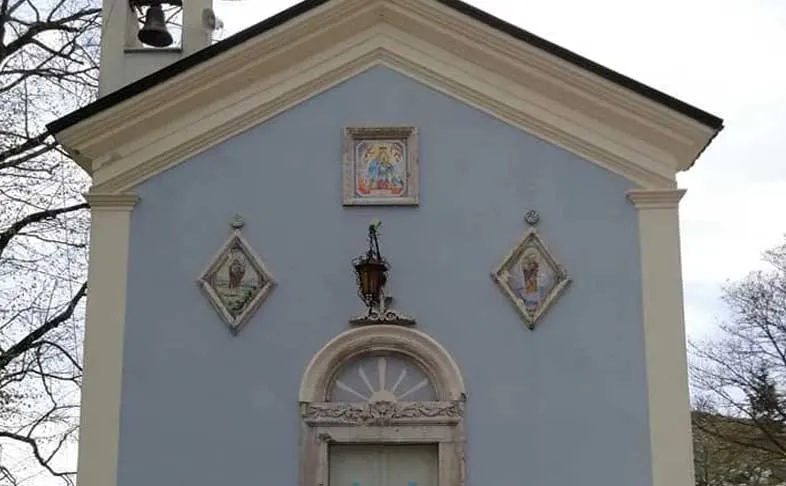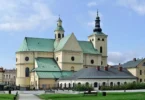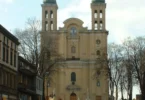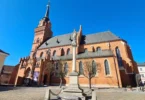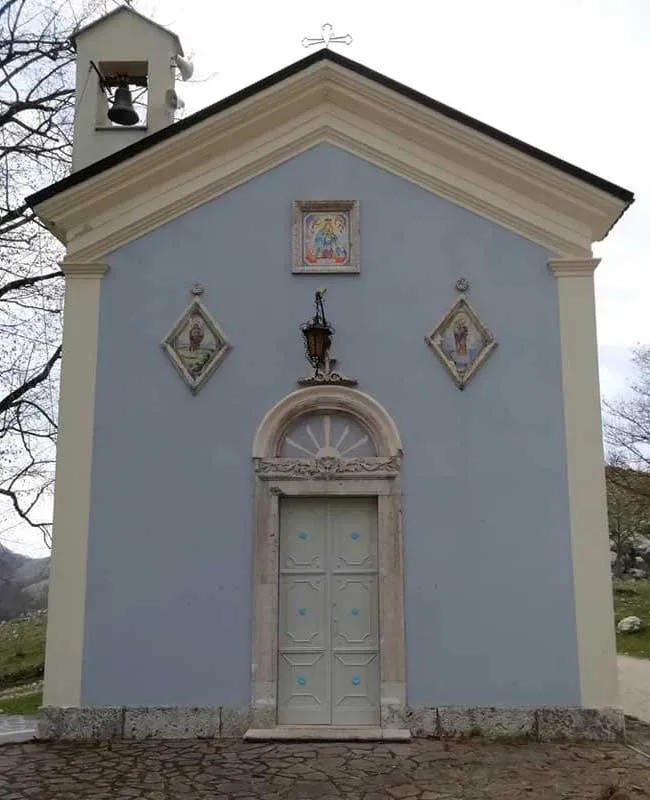
Introduction
The small sanctuary of the Madonna del Carmine, in the parish of San Giovanni Battista in Acquafondata, stands on the provincial road 41, near the pass of the “Serre”, on the extreme offshoots of the Meta mountains at almost 1000 meters above sea level.
Acquafondata is a comune in the Province of Frosinone in the Italian region Lazio, located in the Monti della Meta area, about 130 kilometres southeast of Rome and about 50 kilometres east of Frosinone.
It is immersed in the green of suggestive pine forests, surrounded by large secular lime trees, is 1 km from the center of Acquafondata and less than 2 km from the border with the municipal area of Vallerotonda. According to tradition, the sanctuary was erected on the site of the apparition of the Our Lady of Mount Carmel to Nicolina Carcillo, which took place on July 16, 1841.
The sanctuary is a point of reference for Marian devotion, especially in the month of July, for the inhabitants of the neighboring towns and for those who wish to spend time dedicated to peace, relaxation and spirituality. In the evocative setting of an uncontaminated mountain landscape, the visitor restores himself in contact with nature; the pilgrim is favored in personal and community prayer in specially prepared spaces, such as the ascent path to the “Little Mount Carmel” or the “Path of the XII stars”.
History of Our Lady of Mount Carmel, Acquafondata
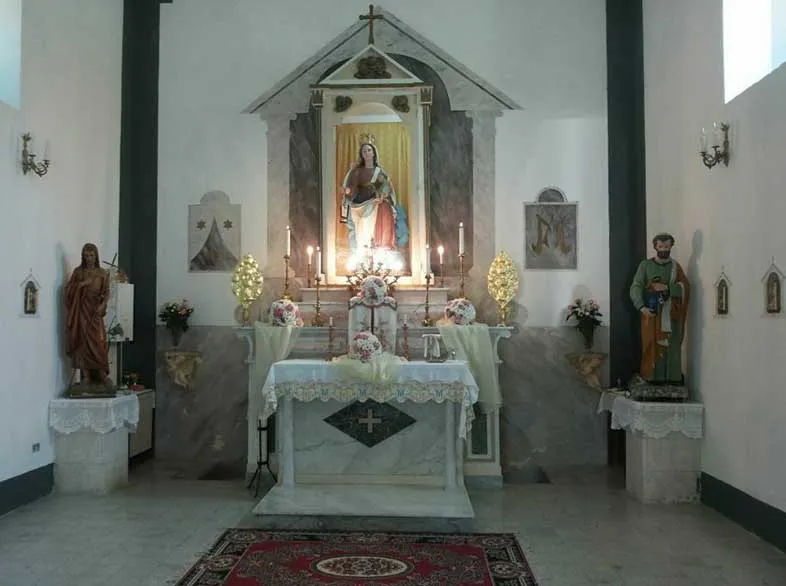
The foundation of the first chapel dedicated to the Our Lady of Mount Carmel in Acquafondata dates back to 1841, as can be seen from the date carved in the architrave of the access door. The small rock construction, built in local stone and pozzolana, has a simple barrel vault, made up of stones wedged between them. This first and humble temple is now incorporated under the altar of the new church, built in the 1930s; it houses the valuable wooden image of the Madonna del Carmine dating back to the end of the 19th century.
The sculpture was transported to the parish church of Filignanoa few years after its construction, to safeguard it from the neglect of the church of Acquafondata due to infiltration of the roof.
Between 1955 and 1960, the structure was recovered, damaged by the war events of the Second World War; the old chapel, unlike the new church, is not damaged. On 5 July 1964 the ancient statue left the parish of Filignano to return to its sanctuary.
Between 1968 and 1969 the holy water font and the altar were built in the large church, and the marble high relief in the old chapel. Also in 1969 a bell was donated and placed in a single lancet window on the roof, to celebrate the first five years since the statue’s return. All of these works are realized at the expense of devoted families and citizens residing in the United States.
In 2014, in memory of the fiftieth anniversary of the return of the statue of the Madonna, a Peregrinatio Mariae took place in the parishes adjacent to the sanctuary, which ended with the solemn coronation of the venerated image, on 30 July of the same year, by the hands of the Apostolic Administrator or of the territorial Abbey of Montecassino. On 30 July 2015, one year after the coronation, the sanctuary was visited by the first bishop of the new Diocese of Sora-Cassino-Aquino-Pontecorvo.
In 2017 a precious local stone altar was erected on the lawn in front of the sanctuary, for outdoor celebrations.
Our Lady of Mount Carmel
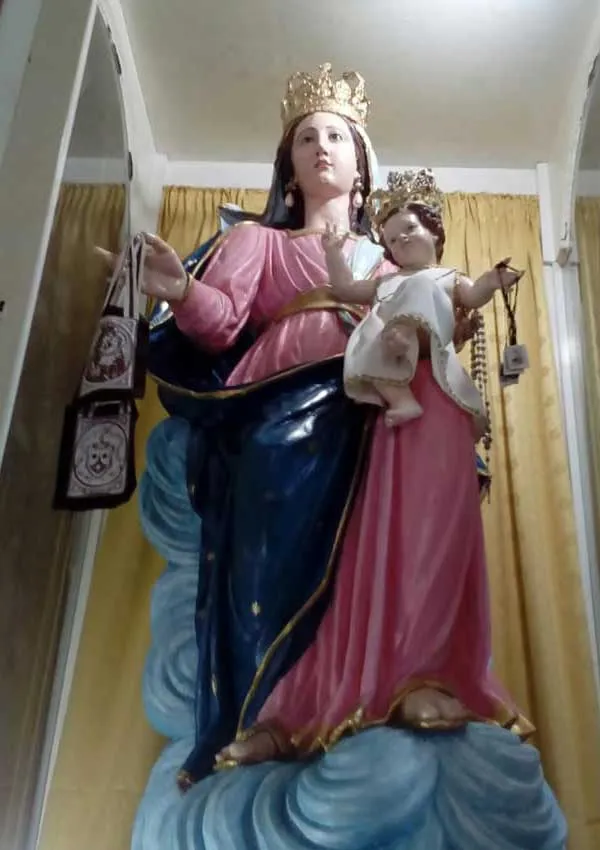
Our Lady of Mount Carmel, or Virgin of Carmel, is the title given to the Blessed Virgin Mary in her role as patroness of the Carmelite Order, particularly within the Catholic Church. The first Carmelites were Christian hermits living on Mount Carmel in the Holy Land during the late 12th and early to mid-13th century. They built in the midst of their hermitages a chapel which they dedicated to the Blessed Virgin, whom they conceived of in chivalric terms as the “Lady of the place.” Our Lady of Mount Carmel was adopted in the 19th century as the patron saint of Chile.
Since the 15th century, popular devotion to Our Lady of Mount Carmel has centered on the Scapular of Our Lady of Mount Carmel, also known as the Brown Scapular. Traditionally, Mary is said to have given the Scapular to an early Carmelite named Saint Simon Stock (1165-1265). The liturgical feast of Our Lady of Mount Carmel is celebrated on 16 July.
The solemn liturgical feast of Our Lady of Mount Carmel was probably first celebrated in England in the later part of the 14th century. Its object was thanksgiving to Mary, the patroness of the Carmelite Order, for the benefits she had accorded to it through its difficult early years.
The institution of the feast may have come in the wake of the vindication of their title “Brothers of the Blessed Virgin Mary” at Cambridge, England, in 1374. The date chosen was 17 July; on the European mainland this date conflicted with the feast of St. Alexis, requiring a shift to 16 July, which remains the Feast of Our Lady of Mount Carmel on the Roman Calendar of the Catholic Church. The Latin poem “Flos Carmeli” (meaning “Flower of Carmel”) first appears as the sequence for this Mass.
History of Our Lady of Mount Carmel
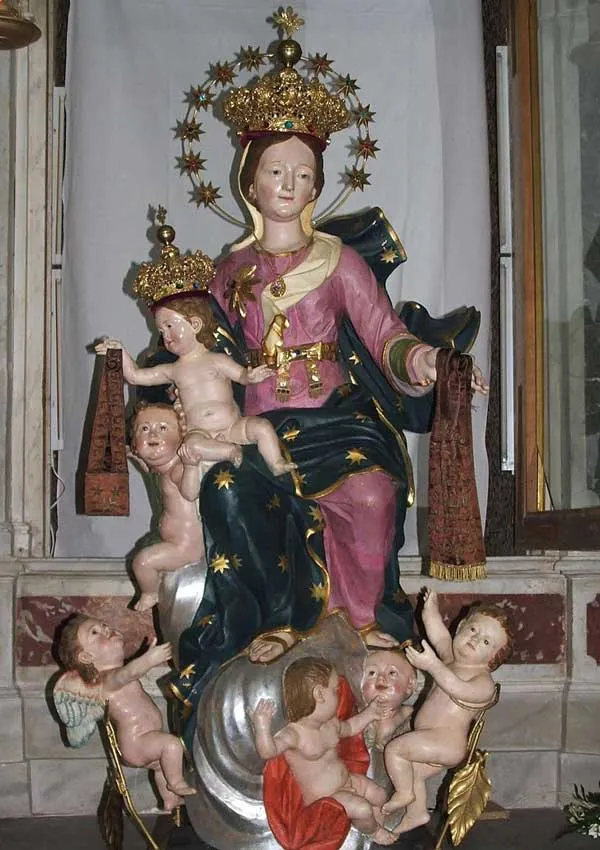
The Carmelite Order was the only religious order to be started in the Crusader States. In the 13th century, some of its people migrated west to England, setting up a chapter and being documented there about 1241–1242. A tradition first attested to in the late 14th century says that Saint Simon Stock, believed to be an early English prior general of the Carmelite Order soon after its migration to England, had a vision of the Blessed Virgin Mary in which she gave him the Brown Scapular.
This formed part of the Carmelite habit after 1287. In Stock’s vision, Mary promised that those who died wearing the scapular would be saved. This is a devotional sacramental signifying the wearer’s consecration to Mary and affiliation with the Carmelite order. It symbolizes her special protection and calls the wearers to consecrate themselves to her in a special way.
In 1642, a Carmelite named Fr. John Cheron published a document which he said was a 13th-century letter written by Saint Simon Stock’s secretary, Peter Swanington. Since the early 20th century, historians have concluded that this letter was forged, likely by Cheron himself.
But Stock’s vision was long embraced by many promoters of the scapular devotion. The forged Swanington letter claimed that 16 July 1251 was the date of the vision (16 July being the date of the Feast of Our Lady of Mount Carmel), which led for centuries to a strong association between this feast day and the scapular devotion. Based on available historical documentation, the liturgical feast of Our Lady of Mount Carmel did not originally have a specific association with the Brown Scapular or the tradition of Stock’s vision of the Blessed Virgin Mary.
This tradition grew gradually, as did the liturgical cult of St. Simon. The latter has been documented in Bordeaux, where Stock died, from the year 1435; in Ireland and England, from 1458; and in the rest of the Order, from 1564. Historians have long questioned whether Stock had the vision of Mary and the scapular. Although Simon Stock was never officially canonized, his feast day was celebrated in the church. The Carmelite convent of Aylesford, England, was restored and a relic of Saint Simon Stock was placed there in 1951. The saint’s feast is celebrated in the places dedicated to him.
Also associated with Our Lady of Carmel was a papal bull saying that there was a Sabbatine privilege associated with devotion to the saint; that is, until the late 1970s, the Catholic liturgy for that day mentioned the scapular devotion. Vatican II resulted in scrutiny of the Feast of Our Lady of Mount Carmel, as well as that of Saint Simon Stock, because of the historical uncertainties about the origins. The liturgies were revised and, in the 21st century, neither, even in the Carmelite proper, makes reference to the scapular.
In Spain and other Spanish-speaking countries, there has been particular devotion to Our Lady of Mount Carmel, who has been adopted as a patron saint of several places, as she has been in other Catholic-majority countries. In addition, Carmen and María del Carmen have been popular given names for girls in Spanish-speaking countries. An annual festival, known as Mamacha Carmen, is held in the highland Paucartambo District, Peru, featuring a procession with the Virgin and traditional dancers. Veneration of the Virgen del Carmen is particularly strong in coastal towns of Spain.
The feast day of Our Lady of Mount Carmel is celebrated for ten days each July in the Williamsburg neighborhood of Brooklyn, New York, where an approximately sixty-five foot tall “giglio” – a tower with a statue of Our Lady of Mount Carmel affixed atop it – is lifted and paraded on multiple dates during the festival. The festival culminates with the celebration of the liturgical feast of Our Lady on July 16.
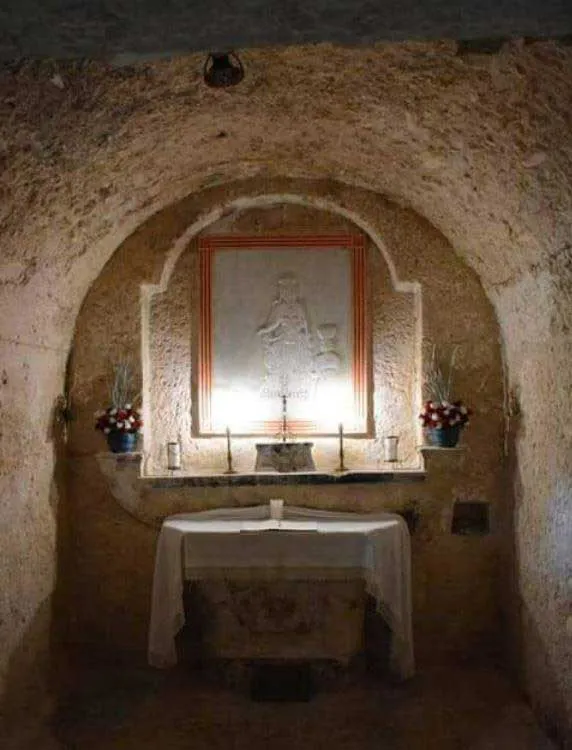
Carmelite Devotion
The Carmelites consider the Blessed Virgin Mary to be a perfect model of the interior life of prayer and contemplation to which Carmelites aspire, as well as a model of virtue, in the person who was closest in life to Jesus Christ. She is seen as the one who points Christians most surely to Christ. As she says to the servants at the wedding at Cana, “Do whatever Jesus tells you.” Carmelites look to the Virgin Mary as a Spiritual Mother. The Stella Maris Monastery (Star of the Sea) on Mount Carmel, named after a traditional title of the Blessed Virgin Mary, is considered the spiritual headquarters of the order.
Fr. Gabriel of St. Mary Magdalene de’ Pazzi, OCD, a revered authority on Carmelite spirituality, wrote that devotion to Our Lady of Mount Carmel means: a special call to the interior life, which is preeminently a Marian life. Our Lady wants us to resemble her not only in our outward vesture but, far more, in heart and spirit. If we gaze into Mary’s soul, we shall see that grace in her has flowered into a spiritual life of incalculable wealth: a life of recollection, prayer, and uninterrupted oblation to God, continual contact, and intimate union with him.
Mary’s soul is a sanctuary reserved for God alone, where no human creature has ever left its trace, where love and zeal for the glory of God and the salvation of mankind reign supreme. Those who want to live their devotion to Our Lady of Mount Carmel to the full must follow Mary into the depths of her interior life. Carmel is the symbol of the contemplative life, the life wholly dedicated to the quest for God, wholly orientated towards intimacy with God; and the one who has best realized this highest of ideals is Our Lady herself, “Queen and Splendor of Carmel”.
Devotees the Blessed Mother of Mount Carmel might raise petitions to her through the prayer: O most beautiful flower of Mt. Carmel, fruitful vine, splendor of Heaven, Blessed Mother of the Son of God, Immaculate Virgin, assist me in my necessity. O Star of the Sea, help me and show me you are my Mother. O Holy Mary, Mother of God, Queen of Heaven and earth, I humbly beseech you from the bottom of my heart to succour me in this necessity. There are none that can withstand your power. O Mary, conceived without sin, pray for us who have recourse to thee. Sweet Mother I place this cause in your hands. Amen.
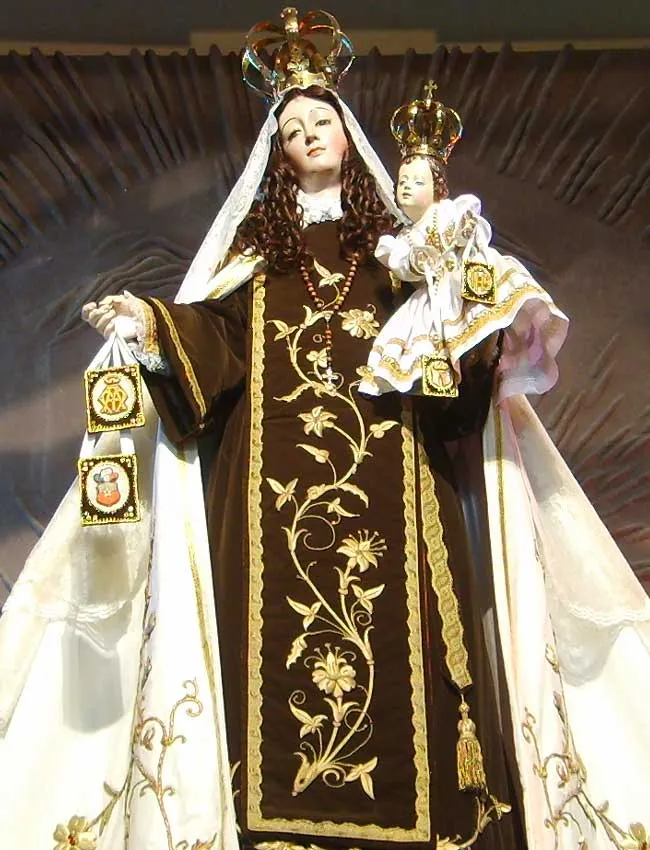
Church Teaching
A 1996 doctrinal statement approved by the Congregation for Divine Worship and the Discipline of the Sacraments states that Devotion to Our Lady of Mount Carmel is bound to the history and spiritual values of the Order of the Brothers of the Blessed Virgin Mary of Mount Carmel and is expressed through the scapular. Thus, whoever receives the scapular becomes a member of the order and pledges him / herself to live according to its spirituality in accordance with the characteristics of his / her state in life.
Discalced Carmelite Fr. Kieran Kavanaugh summarizes this spirituality: The scapular is a Marian habit or garment. It is both a sign and pledge. A sign of belonging to Mary; a pledge of her motherly protection, not only in this life but after death. As a sign, it is a conventional sign signifying three elements strictly joined: first, belonging to a religious family particularly devoted to Mary, especially dear to Mary, the Carmelite Order; second, consecration to Mary, devotion to and trust in her Immaculate Heart; third, an urge to become like Mary by imitating her virtues, above all her humility, chastity, and spirit of prayer.
Association with Purgatory
Since the Middle Ages, Our Lady of Mount Carmel has been related to purgatory and purgation from sins after death. In some images, she is portrayed as accompanied with angels and persons wearing Brown Scapulars, who plead for her mediation. In 1613, the Church forbade images to be made of Our Lady of Mt. Carmel descending into purgatory, due to errors being preached about certain privileges associated with the Brown Scapular (known as “the Sabbatine Privilege”).
That privilege appears in the noted Decree of the Holy Office (1613). It was inserted in its entirety into the list of the indulgences and privileges of the Confraternity of the Scapular of Mount Carmel. In the 21st century, the Carmelites do not promote the Sabbatine Privilege. They encourage a belief in Mary’s general aid and prayerful assistance for persons beyond death, especially her aid to those who devoutly wear the Brown Scapular, and commend devotion to Mary especially on Saturdays, which are dedicated to her.
Apparitions
There is today a small sanctuary at Acquafondata, Italy, where the Virgin of Mount Carmel reportedly appeared on 16 July 1841. The visionaries of Our Lady of Fátima in 1917 reported Our Lady of Mount Carmel as among the titles claimed by Mary. She is said to have appeared to Saint Simon Stock to whom she gave the Brown Scapular. The Garabandal apparitions in Spain (1961–65) were reported to be images of the Blessed Virgin Mary of Mount Carmel.
The Apparition to Nicolina Carcillo
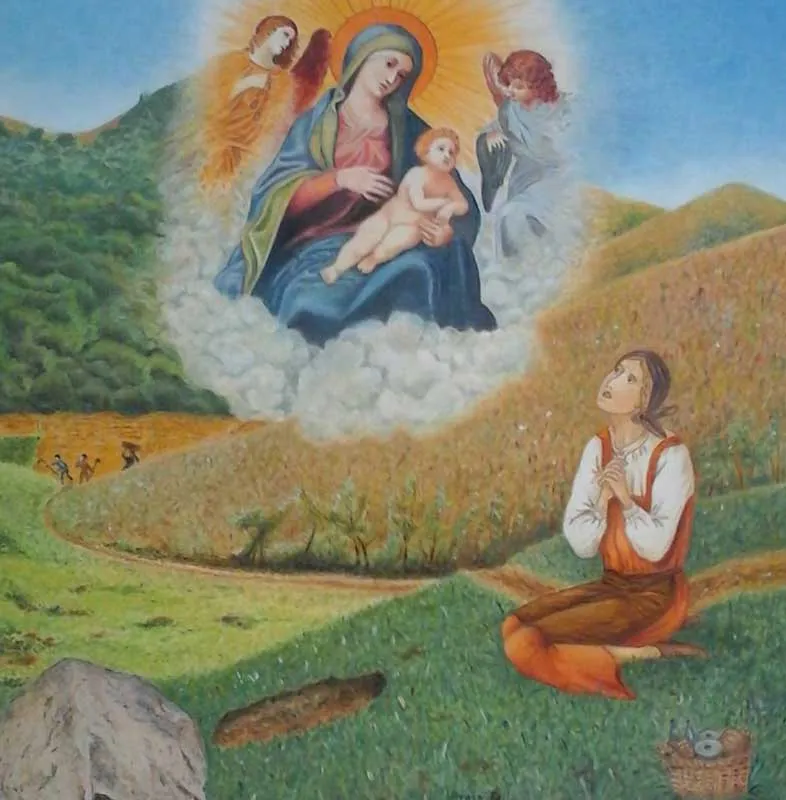
Oral tradition and some written evidence trace the foundation of the sanctuary following the apparition of the Our Lady of Mount Carmel to the peasant Nicolina Carcillo (1783-1862).
On July 16, 1841, the day on which the Church commemorates the Blessed Virgin of Mount Carmel, Nicolina and other peasants from Acquafondata go to the fields as a common working day, ignoring the Marian feast. The Virgin Mary appears to the woman and asks her to promote the construction of a chapel that it becomes a point of reference for the people’s devotion; asks that from then onwards, on July 16, it be respected with religious practice and with the rest from all work activities.
Nicolina is upset, above all she is afraid of not being able to rise to the occasion; in fact, her husband, Benedetto Simeone (1781-1861), is an atheist and will never believe his words, much less help her in the construction of the chapel. Before disappearing, the Madonna leaves her a mark, overturns a huge stone that will be used to convince Benedict and the other farmers.
The testimony of the event was handed down orally among the inhabitants of the area, who helped to build the chapel requested on the place of the apparition, still today a pilgrimage destination and a reference point for Marian devotion. In 1962, the parish priest Don Ferdinando De Filippis and father Passionist Fortunato Marsegli they provided to draw some historical notes on the appearance of 1841, based on the oral tradition, adding reports of other miracles and wonders that the Virgin Mary would operate at the small sanctuary; the news nevertheless remains signs for the believer, interpret-able in the silence of faith and prayer.
It is difficult to understand how much of this story is really to be attributed to a supernatural manifestation; the place however remains the object of a particular Marian devotion , the small chapel has acquired the sacred character of a sanctuary because it remains linked to the veneration that Catholics bestow on the Virgin Mary.
The small chapel in honor of the Our Lady of Mount Carmel, built in 1841 by the Simeone spouses, together with the small church built after the first construction, have become dear to many devotees, regardless of the veracity of the traditional story. The Church has never been expressed in an official recognition regarding the apparition, however the authorization of the cult in the small chapel, the visits of the Bishops, the celebrations that take place there with the participation of pilgrims and devotees, reveal a factual recognition.
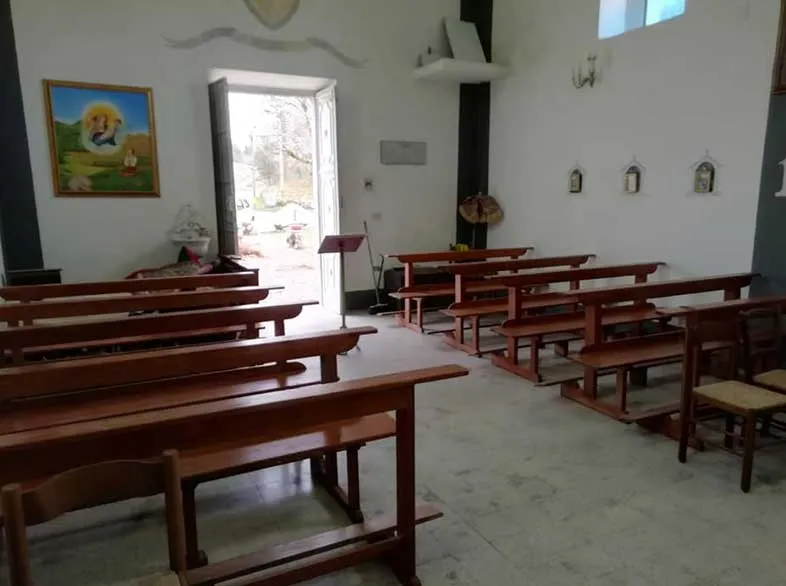
Miracles
In Palmi, Italy, the anniversary of the earthquake of 1894 is observed annually on 16 November. The earthquake had its epicenter in the city. An associated event has been classified as the “miracle of Our Lady of Mount Carmel.” For 17 days preceding this earthquake, many of the faithful had reported strange eye movements and changes in the coloring of the face in a statue of Our Lady of Mount Carmel. The local and national press reported these occurrences.
In the evening of 16 November, the faithful improvised a procession carrying the statue of the Virgin of Carmel on their shoulders through the streets. When the procession reached the end of the city, a violent earthquake shook the whole district of Palmi, ruining most of the old houses along the way. But, only nine people died out of a population of about 15,000 inhabitants, as almost all of the population had been on the street to watch the procession and were not trapped inside the destroyed buildings. Therefore, the city commemorates the 1894 procession each year, accompanied by firecrackers, lights, and festive stalls.
The Catholic Church has officially recognized the miracle. On 16 November 1896, the statue of the Virgin was crowned, based on the decree issued 22 September 1895, by the Vatican Chapter.
Holidays and Anniversaries in The Sanctuary
- Easter Monday opening of the sanctuary after the winter break.
- The “Ascent of the Madonna” on the first Saturday of July First Saturday of July : pilgrimage on foot of the communities adjacent to the sanctuary for the opening of the month dedicated to the Madonna del Carmine. The statue of the Madonna leaves the parish church of Acquafondata, kept there in the winter, and is carried in procession to the sanctuary.
- From 1 to 16 July : every afternoon at the sanctuary celebration of the Holy Mass and the “sedicina” in preparation for the feast.
- July 16 : (liturgical memorial of Our Lady of Mount Carmel and anniversary of the apparition) evening Mass and torchlight procession accompanying the statue of the Madonna to the parish of Acquafondata.
- Last Saturday of July : (remembrance of the solemn coronation of 2014) procession from the parish of Acquafondata, the statue of the Madonna returns to the sanctuary and remains there for the whole month of August.
- 28 August : Acquafondata pilgrimage on the eve of the patronal feast of the community; from the sanctuary a solemn procession accompanies the statue of the Madonna in the parish church where it will remain kept until July of the following year.
- Indoor 8 December (Immaculate Conception) Concluding celebration at the end of the sanctuary for the winter break.
Feast Day – 16th July
The liturgical feast of Our Lady of Mount Carmel is celebrated on July 16. The solemn liturgical feast of Our Lady of Mount Carmel probably was first celebrated in England in the later part of the 14th century. Its object was thanksgiving to Mary, the patroness of the Carmelite Order (“Brothers of the Virgin Mary”) for the benefits she had accorded to the order through its difficult early years.
The date chosen was July 17; on the European mainland this date conflicted with the feast of St. Alexis, requiring a shift to July 15, which remains the Feast of Our Lady of Mount Carmel throughout the Catholic Church. The Latin poem “Flos Carmeli” (meaning “Flower of Carmel”) first appears as the sequence for this Mass.
Contact Info
SP41, 03040 Acquafondata,
Province of Frosinone, Italy
Phone No.
Tel : +39 0776 584432
Accommodations
How to reach the Sanctuary
Naples International Airport serving Naples and the Southern Italian region of Campania is the nearby Airport to the Sanctuary.
Venafro Transit Station in Venafro, Province of Isernia, Italy is the nearby Transit Station to the Sanctuary.

